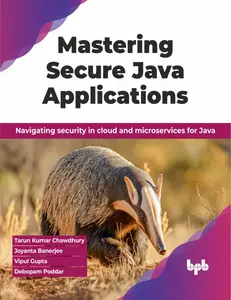
Free Download Mastering Secure Java Applications: Navigating security in cloud and microservices for Java (English Edition) by Tarun Kumar Chawdhury, Joyanta Banerjee, Vipul Gupta
English | March 4, 2024 | ISBN: 9355518846 | 344 pages | MOBI | 4.57 Mb
Elevate your Java security skills for the modern cloud era
Key Features
● Understanding Zero-Trust security model for Java.
● Practical cloud security strategies for developers.
● Hands-on guidance for secure Java application development.
Description
This book offers a comprehensive guide to implementing Zero-Trust security principles, cloud-based defenses, and robust application development practices. Through practical examples and expert advice, readers will gain the skills needed to design and develop secure Java applications that easily can tackle today's cyber threats.
It builds focus on securing your source code through analysis, vulnerability detection, and automation. It also ensures the safety of your runtime environment for managing traffic and enables multi-factor authentication. While addressing data security concerns with encryption, anonymization, and cloud-based solutions, it also uses tools like OpenTelemetry for real-time threat detection. It manages sensitive information securely with Vault integration and explores passwordless authentication. Reference architectures, secure coding patterns, and automation practices are also provided to aid implementation.
By the end of this book, you'll be well-equipped to build secure Java applications with confidence and deliver applications that are robust, reliable, and compliant.
What you will learn
● Implement Zero-Trust principles in Java applications.
● Secure Java apps in cloud environments like AWS, GCP, and Azure.
● Develop applications with security best practices from the ground up.
● Understand and mitigate common security vulnerabilities in Java.
● Apply modern security tools and techniques in Java development.
Who this book is for
This book is ideal for Java developers and software architects seeking to enhance their security expertise, particularly in cloud environments.
Table of Contents
1. Secure Design Principles for Java Applications
2. Analyzing and Securing Source Code
3. Securing Java Runtime
4. Application Data Security
5. Application Observability and Threat Protection
6. Integration with Vault
7. Established Solution Architecture and Patterns
8. Real-world Case Studies and Solutions
9. Java Software Licensing Model
10. Secure Coding Tips and Practices
